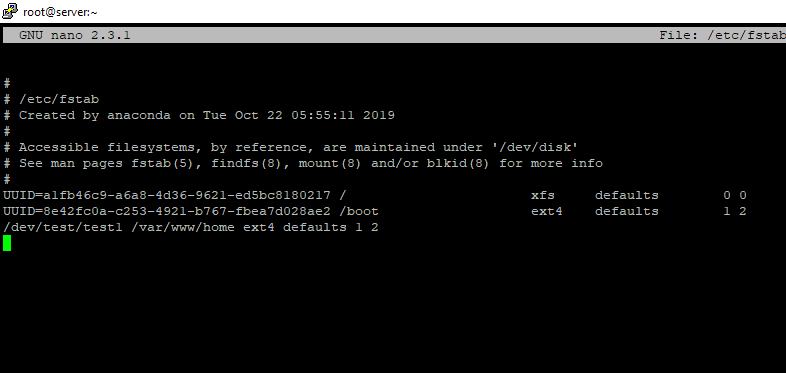

It should contain the type of mount plus any additional options. On many newer systems it is quite common to see devices specified by their " UUID" Universal Unique Identifier.įield Two: Mount Point field - For a " swap" partition this field should be specified as "none".įield Three: This field describes the type of filesystem - Linux can support many different filesystems - "ext2, ext3, ext4, hfs, iso9600, minix, msdos, nfs, ntfs, reiserfs, smbfs, vfat, xfs plus many more." For filesystems supported by the running kernel see "/proc/filesystems".įield Four: This field describes the mount options associated with the filesystem - This is a comma separated list. The " bg" specifies that it should be mounted as a background task. The above " nfs" example will mount " /opt/test" from the remote server " rmtserver" on the local mount point " /mynfs". rmtserver:/opt/test /mynfs nfs ro,bg 0 0 These can be identified easily by the "nfs" These are filesystems that are hosted by a remote server. Ordinary mounts such as "/dev/vdb1" can be seen here. There are six fields for each entry:įield One: Filesystem - This field describes the device or filesystem that is to be mounted. Each field is separated by spaces or a tab. Each line within the file describes the device/filesystems that are available to your system. This file is generally maintained by the system administrator of the server. The location of the mount table is held in a file located in the following path: " /etc/fstab". dev/mapper/sysVG-swapLV none swap defaults 0 0

dev/mapper/sysVG-varLV /var xfs defaults 0 0

dev/mapper/sysVG-usrLV /usr xfs defaults 0 0 dev/mapper/sysVG-tmpLV /tmp xfs defaults 0 0 dev/mapper/sysVG-spareLV /spare xfs defaults 0 0 dev/mapper/sysVG-optLV /opt xfs defaults 0 0 dev/mapper/sysVG-homeLV /home xfs defaults 0 0 dev/mapper/sysVG-rootLV / xfs defaults 0 0
Fstab defaults update#
# After editing this file, run 'systemctl daemon-reload' to update systemd # See man pages fstab(5), findfs(8), mount(8) and/or blkid(8) for more info. # Accessible filesystems, by reference, are maintained under '/dev/disk/'. # Created by anaconda on Mon Apr 5 13:23:42 2021 Below is a copy of the mount table used for our previous example Creating Filesystems and Partitions. This is a file that contains information regarding partitions that should be mounted at boot time. For more details see netfs.What is a Filesystem? Linux's Mount Table /etc/fstabĪs we saw previously in our example of creating multiple partitions on one disk that we need to add our devices and mount points into Linux's mount table. If the sixth field is not present or zero, a value of zero is returned and fsck will assume that the filesystem does not need to be checked.Įven if a network file system is specified in /etc/fstab, the filesystem is not mounted unless netfs service is started. Filesystems within a drive will be checked sequentially, but filesystems on different drives will be checked at the same time to utilize parallelism available in the hardware. The root filesystem should be specified with a fs_passno of 1, and other filesystems should have a fs_passno of 2. Is used by the fsck program to determine the order in which filesystem checks are done at reboot time. If the fifth field is not present, a value of zero is returned and dump will assume that the filesystem does not need to be dumped. Is used for these filesystems by the dump command to determine which filesystems need to be dumped. For the filesystems currently supported by the running kernel, see /proc/filesystems/.ĭescribes the mount options associated with the filesystem. If the name of the mount point contains spaces these can be escaped.ĭescribes the type of the filesystem. dev/vdb1 /support-nfs-storage xfs defaults 0 0ġ92.168.1.4:/volume1/wiki /rackstation/wiki/ nfs4 defaults 0 0ĭescribes the block special device or remote filesystem to be mounted.ĭescribes the mount point for the filesystem.

dev/mapper/vg_oceanlab-lv_swap swap swap defaults 0 0ĭevpts /dev/pts devpts gid=5,mode=620 0 0 dev/mapper/vg_oceanlab-lv_home /home ext4 defaults 1 2 dev/mapper/vg_oceanlab-lv_root / ext4 defaults 1 1


 0 kommentar(er)
0 kommentar(er)
